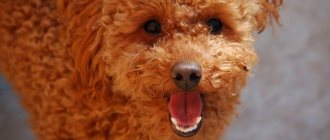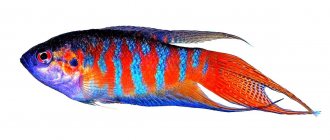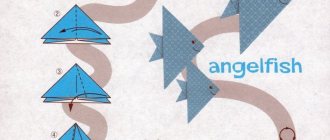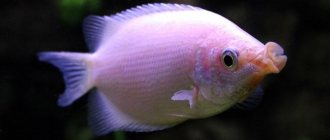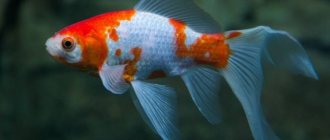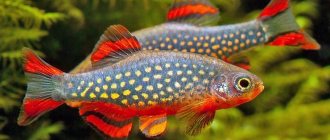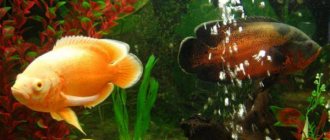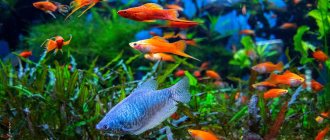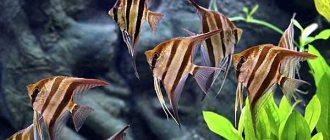The Oranda fish from the Carp family, a variety of Veiltail, is beloved by aquarists for its unusual appearance and beautiful bright colors. The predecessor of the breeding series is Golden Crucian. This variety was bred in Japan in the 15th century, although China is considered its homeland. In Japanese, the name Oranda sounds like "shishiga-shira". The ability to breed specimens of original colors makes it popular among aquarists in all countries, including Russia.
Description and selection features
Oranda is one of the subspecies of the familiar goldfish, numbering about 300 breeds with different colors.
Its main distinguishing feature is considered to be numerous growths on the head, similar to large fused warts. Sometimes they grow on the gills and around the telescopic eyes, which interferes with the view of the comet fish, as breeders often call it. In such cases, it is recommended to trim the growths - the procedure is not painful for the fish and improves the quality of life. By the age of two, a fully formed Wen, which means hood in Japanese, becomes a source of pride for a conscientious breeder of this aquarium inhabitant.
It grows up to 20 cm, although acceleration is possible, and some individuals can reach 38 cm. The tail in the form of a beautifully flowing veil is similar to a typical gold fish.
Recently, an unusual Thai Orand breed was bred, the tail fin of which became torn, short, located at right angles to the body.
It usually lives 10-15 years, although under ideal conditions it can become a 40-year-old centenarian.
Photo gallery of Oranda:
The most common colors are red, orange and their spotted combinations. There are also calico, mother-of-pearl, panda and even black colors. There are two color types: the white-blue or spotted body of the fish and the colored one with a metallic tint. The scales can be large or small, and scaleless specimens are also found. The greatest value for aquarists in this breed is the size of the warty cap - the larger, the more expensive the individual.
This fish can live in home ponds and artificial reservoirs, provided they are kept in very warm and clean water. Intolerant of temperature changes and foreign particles that get clogged in the folds of the growth and cause disease.
Major diseases
If this fish is not sick, then it has shiny scales, a bright color and high mobility. And this is not to mention the wonderful appetite. If there are deposits on the body that look like lumps of cotton wool, the fins stick together, the fish begins to swim in jerks, rubs against objects, breathing is impaired or the fins turn red - this means that this is a deviation from the norm and requires immediate treatment.
In this case, special mixtures have been developed for goldfish, but in addition to this, they need to be fed with live and plant food. If fish care is poor, then disease is inevitable. But this rarely happens to caring owners. The most important thing is to remember that such a beauty as “Little Red Riding Hood” requires a lot of attention and care.
Mr. Tail recommends: Oranda varieties
A description of the various subspecies of Oranda, most often found in nature, is presented in the table.
| Name | Body color and shape | Growth color | Features of fins |
| Little Red Riding Hood | White or light pink. | Bright red. | Forked, except for a fused tail on a round short body. |
| Red and white | Red and white spots on the body with bizarre shapes. | Red, orange. | Long, veil-shaped. |
| Chocolate | Brown with a metallic sheen. | Dark brown. | Short, round. |
| Dark gray | Gray with a metallic tint. | Dark grey. | Short, rounded. |
| Dutch lionhead | Lemon yellow with red fins and tail. | Red, scarlet. | Small raised tail, often forked; the dorsal one is missing. |
| Giroshima | Silver. | An orange top of the head instead of a cap, two grayish growths at the edges of the mouth. | No fin on the back. |
| Blue* | Blue, closer to gray, velvety, bluish spots on the back. | Blue. | Darker than body color. |
* – a recently bred breed, less sensitive to temperature changes and loving cool water, extremely beautiful.
Description
The aquarium redcap is a helmet-shaped species of artificially bred fish; it differs from other similar species in its unpaired dorsal fin. Other helmeted breeds lack a dorsal fin. The remaining fins of the fish are forked and hanging, including the tail, which is 70% long of the entire body of the oranda. The most valuable specimens of the red cap have a tail that resembles a skirt shape, like a veiltail. The tail should not be fork-shaped, which indicates a defect in the breed. Adults reach 16-24 cm in length.
The body is ovoid and short. The fins are translucent and elongated. It is difficult to distinguish fish by gender. Males are smaller than females, and white spots appear on their heads during the pre-spawning period.
There are various varieties of this fish, among which the white fish, whose heads are decorated with a red cap, are considered especially beautiful. Black, blue and chocolate varieties are also known. The black fish is painted completely black along with its cap. You can often find golden oranda and calico. By nature, these creatures are quite sweet and gentle, requiring careful and caring maintenance. Good and high-quality care will allow you to enjoy the company of the Oranda for up to 15 years.
Return to content
Aquarium Basics
The aquarium for Oranda will need a large one - 50 liters for one fish and 250-300 liters for two or three pairs. The Little Red Riding Hood's habitat must have the following conditions:
- powerful filter and rich aeration;
- water in an aquarium with the following indicators: temperature +18...+25 °C, hardness 12-16 dGH, acidity 6-8 pH;
- the bottom is covered with light rounded gravel of medium and large sizes;
- large-leaved plants without sharp edges, for example, egg capsule, vallisneria, elodea;
- availability of free space for movement, which serves as the prevention of metabolic disorders;
- changing water at least once a week in the amount of 25-40% of the volume.
The aquarium fish Oranda is an active digger, so the water in the reservoir often becomes cloudy. Regular cleaning and intensive biological filtration will ensure a long and active life for your pet.
Conditions of detention
One goldfish should have at least 50 liters, so it is advisable if the aquarium volume is 100 liters or more. When kept in groups, this ratio decreases slightly, so 5-6 fish will feel great in a 200 liter container. The best option would be a long, low aquarium with good aeration and a powerful filter, since this species is sensitive to a lack of oxygen. Oranda care includes weekly water changes of 1/3 of the total volume.
The water parameters for comfortable keeping of oranda are as follows:
- acidity – 7.0 pH;
- hardness – up to 6-18 dGH;
- temperature – 18-24°C.
Like other goldfish, the red cap loves to dig in the ground. In this regard, the substrate should not be too small or have sharp corners. Coarse river sand or fine gravel are perfect; pebbles would be a good idea. This aquarium fish needs room to swim and plenty of light.
You should not decorate the aquarium with grottoes, rocks and other similar decorations, since the clumsy and clumsy oranda can injure its fins from them.
Plants must either be planted in pots or pressed tightly with rounded heavy stones, otherwise the oranda will certainly dig them up and damage the roots. For an aquarium with red caps, Vallinesneria, Elodea, and Saggitaria are perfect.
Compatibility
Goldfish in general, like the Shishiga Shira, are peaceful creatures that like to live in schools of their own species. They easily get along with relatives of the carp family and catfish. The main thing is that the neighbors are not aggressive and smaller in size. The slowness of the Oranda gives some predatory species a reason to nibble on its delicate veil-shaped fins. Cockerels and swordtails are considered such unwanted cohabitants. The small inhabitants of the Neon Comet aquarium can easily be swallowed. Barbs and mollies are too active for such cohabitation.
Nevertheless, experienced goldfish breeders recommend keeping them separately from other species, since it is difficult to maintain the cleanliness of the reservoir and the conditions necessary for their more active relatives.
Features of behavior and compatibility
Despite its rather large size, the red cap is a peaceful fish. Likes to be in the company of his own kind. It is better not to house this species with aggressive fish, even if they are much smaller . Swordtails, cockerels, and barbs will nibble on the delicate veil fins. Undesirable neighbors - mollies, neons. Oranda can swallow fry and small fish.
Red caps get along best with their own kind and other peaceful fish species.
The following types are well compatible:
- telescope;
- comet;
- shubunkin;
- guppy;
- cardinal;
- zebrafish;
- thorns;
- catfish.
Feeding
Oranda's diet consists of any type of food, but the portion size must be observed. Adult fish are fed once a day, and young fish twice a day. Since she is prone to overeating, you can determine the sufficient amount of food by the following observation: Oranda swims on her side when she has eaten more than normal. Remains of food after a twenty-minute meal must be removed.
It is believed that plant foods such as salads and spinach affect the brightness of the body color and cap of Asians. Live daphnia, worms and bloodworms are also necessary in the diet, as are carbohydrate-rich plants.
To keep your pet healthy and cheerful, it is advisable to alternate types of food - dry with live, plant-based with protein.
Oranda species
They differ according to the following criteria: body shape, color, size of scales and fins. Oranda red - also called the red cap, thanks to the red fatty growth that covers the entire head except the eyes.
Her body is swollen, egg-shaped, slightly oblong. The fins and tail are large, translucent, and elegantly developing. Compensating for and decorating the small body, it is soft white in color.
Golden oranda - its maintenance conditions are the same as for other types of goldfish. It got its name due to its bright orange color, like a fairy-tale goldfish. The body is oblong, slightly flattened. The fins on the belly and the tail are rounded.
In the photo there is a golden oranda
Oranda black - in spacious aquariums and home ponds it grows more than fifteen centimeters in length. It has a round shape, with a large black cap on its head. With large black fins and a fork-shaped tail. The scales are not small, with a beautiful golden-black tint.
The photo shows a black oranda
Oranda is white - or white - red. Small round goldfish. With a huge cap on its head, bright red, orange or pale yellow. With shiny white scales and gorgeous silky fins and tail.
The photo shows a white oranda
Blue oranda is a hardy fish, well suited for cold-water aquariums or small ponds located outside in the garden. Loves well-lit places and lots of space. Its scales are colored gray-blue, with bluer spots on the back.
Round body with large fins and tail. It is very important in keeping goldfish to correctly determine their gender, especially for those who are aiming to breed them. But it’s difficult to do this if the fish is not at least a year old.
The photo shows a blue oranda
There are several differences. The easiest time to do this is during the spawn period. In oranda males, light tubercles appear at the level of the pectoral fins. Also in this area, scales with sharp jagged ends grow, and after several periods of spawning, this area of the body becomes much harder.
From the rear pelvic fins to the anus, males grow a characteristic growth. And the scales there are tough. The fins themselves on the abdomen are pointed in shape; in the female they are rounded and shorter.
Males are duller in color than females and are less active. Also, when they see a new passion in their habitat, males will swim up to their future chosen one with great interest. The period of puberty in goldfish reaches two years of life, and it is preferable to keep two females for one male.
Breeding
To breed offspring, an aquarist needs a special aquarium of 50-100 liters - a spawning tank. The water in it should be 4-6 °C lower than usual. A sand hill is made at the bottom, a special net for eggs is installed, and thick algae with soft leaves are planted.
For successful reproduction of healthy individuals from 18 months and older, they need to be fed live food for a long time, which is often replaced with pieces of meat. During this period, usually in the spring, the female’s belly swells with eggs, and the gills of the males become covered with small bubbles. The day before transplanting two males and a female into a separate container, the fish are not fed.
After spawning, which lasts 4-5 hours, the fish are transplanted back, and cloudy, lifeless eggs are removed from the spawning tank and part of the water is drained. After 3-4 days, the fry appear and are fed live dust.
Reproduction and lifespan
Oranda reaches sexual maturity at the age of 1.5-2 years. For breeding, a female and 2-3 males are selected and kept in separate containers before spawning. Sexual demorphism in the red cap is almost not expressed; you can determine who is who only by size (males are smaller). An aquarium with a volume of about 30 liters is suitable as a spawning tank, at the bottom of which small-leaved plant species are placed and pressed firmly with rounded stones. The soil must be sandy.
The temperature in the spawning tank is slowly reduced by a couple of degrees. Spawning usually begins early in the morning and lasts several hours, after which the spawners are removed. Larvae appear on the 5th day, fry – after another 2 days. The starting food for them is live dust.
Video: Red Cap oranda spawning
Under good conditions, oranda lives in an aquarium for about 15 years.
Diseases and prevention
Oranda's pride is the growth on her head, which is at the same time the main source of health problems. Fungi, infections and mold can easily settle in the folds of the cap and spread as soon as they enter the aquarium. This happens when the water is heavily polluted, so keeping your home pond clean is a top priority.
If the water temperature in the habitat suddenly drops or unwanted neighbors appear there, small white bulges appear on the Oranda’s body, which indicates a disease such as ichthyophthyriosis. If the necessary living conditions are restored, the water is cleaned and incompatible inhabitants of the home are resettled, this disease will not require additional treatment.
A common problem is considered to be an upset of the goldfish's gastrointestinal tract due to the ingestion of indigestible small particles from the soil.
If the aquarist observes the necessary conditions for keeping Oranda - a clean reservoir, constant water temperature, compatible neighbors, then the fish will live a long and healthy life to the delight of its owner.
Features of maintenance and care
To keep red caps, oblong-shaped aquariums are used. In terms of capacity, they are selected so that 1 fish has 50 liters of volume.
The more densely populated the aquarium, the more intense the aeration of the water. For these purposes, compressors are used and suitable (hard-leaved and large-leaved) plants are planted:
- egg capsule;
- sagittaria;
- Elodea;
- fern;
- Cyperus.
More often, preference is given to algae with a strong root system, otherwise the bases of the plants have to be additionally secured with large stones.
Also, the oranda owner needs to make sure that there are no sharp pebbles or needle-like snags in the aquarium, since goldfish like to rummage in the ground and can easily get hurt.
Male cockerel Veiltail red (size XL)
Fin rot is caused by the bacterium Pseudomonas, which entered the water along with food or new inhabitants. Usually it clings to young or weakened individuals, but if detected untimely, it can destroy the entire population of the aquarium. The symptoms are:
- Lethargy.
- Sudden change in color.
- Ulcers or bluish plaque on the body.
- Cloudiness of the cornea.
- Blowing bubbles;
- Ugly, drooping, stuck together fins.
Externally, the fins look frayed, rotting, and you can see that they are stuck together. Additional symptoms include discoloration, sores on the body, and lethargic behavior. Treatment:
- Bicillin-5 (penicillin substance with bactericidal action).
- Biomycin (general purpose antimicrobial antibiotic).
- Malachite green. Treatment is carried out for a maximum of five days (gradually increasing the dosage from 0.5 to 0.7 ml). Only freshly prepared solution is used, the processing process takes five hours.
- Violet K (chlorohydrite). The substance is diluted in proportions of 0.1 grams per liter. Having applied 15 ml of solution, add it to 15 liters of water and pour it into the aquarium.
Antibiotics are given for a couple of months (the norm is 20 grams per 100 liters).
Ichthyophthyriasis (semolina) The causative agent of ichthyophthyriasis or “white semolina” in cockerels is a ciliated ciliate. Parasites can come from live food, equipment or a sick individual. The cause of the disease is also considered to be stress due to low temperature and hard water. Signs of the disease can be detected approximately 4-6 days after infection. The symptoms are:
- Lack of appetite.
- Slow breathing;
- Impaired coordination of movements.
- Decreased activity.
- Weight loss.
White dots similar to “semolina” appear on the fish’s head, which spread throughout the body, the cockerel becomes lethargic, rubs against the ground and other objects, eats poorly, trembles, and swims in jerks. Treatment:
- Methylene blue;
- Malachite green;
- Bicillin-5;
- Antipar;
- Tripaflavin;
- TetraMedica Contralck;
- Sera Costapur.
The dosage of the medicine must be in accordance with the instructions. Ichthyophthiriasis is not considered a serious disease; to treat it, the infected cockerel is placed in a separate container, where the water temperature should be 30 degrees.
Exophthalmia (bulging eyes) The main cause of exophthalmia is kidney failure. The reasons for poor kidney function in fish can be very different. The symptoms are:
- The eyes become cloudy;
- They crawl out of their sockets;
- The eyes become covered with a white film;
- Decreased activity.
With exophthalmia, the cockerel's eye bulges and comes out of its orbit. It becomes cloudy on the outside. Usually one eye is affected, but both eyes can be damaged. Treatment:
- Epsom salt (magnesium sulfate);
- Ampicillin;
- Erythromycin;
- Minocycline;
- Trimetropin;
- Sulfadimidine;
- Water pH measurements.
The sick cockerel is moved to a separate tank (hatchery) and treated with Epsom salt. A complete water change and disinfection of the aquarium must be carried out.
Dropsy Ascites is caused by metabolic disorders, improper feeding, Ichthyosporidium fungus, bacterial and viral infection. The symptoms are:
- Enlarged abdomen;
- Red spots at the base of the fins;
- Rapid breathing;
- Refusal to eat;
- Ruffled scales;
- Bruising on the body;
- Swollen eyes;
- Dingy white feces;
- Fast weight loss.
Treatment:
- Violet K (for treatment in the septic tank);
- Bicillin 5 (for treatment in a general aquarium);
- White streptocide;
- Maracyn;
- Chloramphenicol;
- Tripaflavin;
- Maracin;
- Baktopur Direct;
- A weak solution of potassium permanganate.
Basically, dropsy leads to the death of betta fish. You can try to cure the initial stages of the disease. If therapy is unsuccessful, the cockerels are killed, the aquarium and its contents are disinfected.
Oodiniosis: stuck together fins The causative agent of oodiniosis, or oodinosis, or oodiniumosis, or corduroy disease, or coliosis disease, or pillulariasis is a single-celled organism - the dinoflagellate Piscnoodinium pillulare (synonym Oodinium limneticum). The symptoms are:
- Breaking and splitting scales;
- Loss of color brightness;
- The presence of yellow plaque on the body;
- Apathy;
- Labored breathing;
- Drooping fins.
The skin on the head of the fish is destroyed in places, the body, fins and gill covers are covered with very fine golden-yellowish dust, which is very, very difficult to see with the naked eye. But through a regular magnifying glass, numerous small bright dots-tubercles are already clearly visible. Treatment:
- Antipar (an antiseptic that affects fungus).
- Seraoodinopur (water condenser).
- Formamed (a drug against invasive diseases and maintaining a healthy environment).
- Ichthyofo (a substance based on two septic tanks: formalin and malachite green).
Please note: if at least one individual is unwell, it is necessary to carry out complete disinfection and treatment of the rest. Otherwise, the underwater beauties will infect each other, and the disease will drag on indefinitely. During quarantine, maintain an elevated water temperature.
Columnariosis (Flexibacteriosis) From the group of myxobacteria for aquarium fish, the greatest danger is the causative agent of columnariosis - Flavobacterium columnare, the outdated but traditional name of this bacterium is Flexibacter columnaris - hence the most common name for the disease - flexibacteriosis. Currently, it is more correct to use the term columnaria. The symptoms are:
- Lethargy.
- The desire to hide in a secluded place.
- Dark coating on the gills.
- Mouth damage.
- The appearance of cloudy fluid in the eyes.
At the beginning of the disease with Columnaria, the fish compress their fins, their movements become constrained, whitish edges appear along the edges of the scales, then there is a strong mucus on the surface of the fish’s body. Treatment:
- Baths with table salt;
- Methylene blue;
- Erythrocycline and table salt;
- Baths with phenoxyethanol;
- Oxacillin;
- Oleandomycin;
- Rivanol;
- Lincomycin;
- Levomycetin;
- Geomycin;
- Tetra Medica General Tonic;
- Sera baktopur;
- Merbromin
Treatment of fungus in betta fish begins with the use of complex remedies, the use of disinfectants, and baths with phenoxyethane. Some people suggest adding methylene blue or Merbromin to promote faster healing.
Injuries Minor injury to the betta, will heal on its own, provided the water quality in the aquarium is good. If your pet is seriously injured, your help is needed. If the damage is not severe, the betta fish should gradually recover on its own. To ensure rapid healing of mechanical damage, use:
- Methylene blue;
- Melafix;
- Black tea;
- Peat extract;
- Table salt 3g/1l.
Severe wounds are smeared with antibiotic ointment or a weak iodine solution. The cockerel can also be kept in a weak solution of furatsilin, manganese or other antiseptic. In case of poor chemical composition and hard water, wounds can become infected, which is why they do not heal for a long time or are affected by fungi. It is important to distinguish mechanical damage from diseases that cause ulcers to appear on the body. To treat the latter, cleanliness, rest and treatment are not enough; the use of antibiotic baths will be required, depending on the pathogen.
Price and reviews about oranda
buy oranda in any pet store, online store or from hand, since aquarium farming is already very developed in our time. Also, by purchasing in specialized places, beginners can receive qualified advice from specialists on their contents.
The price of an oranda depends on its external characteristics; the larger the cap on its head, the more valuable the fish, and also on the breed. Starting from forty rubles for a golden veiled tail. Black gold oranda is more expensive - from one hundred rubles. But there are also more expensive, already adult specimens costing five hundred rubles and more.
Reviews are very different - very beautiful shiny fish, with chic hats and tails. They quickly get used to the owner and wait for his presence, cunningly begging for an extra meal. Very hardy and nimble fish, they grow and develop quickly.
The negative thing is that they pollute the water and eat the fry. They eat aquarium greens. Some breeds are difficult to obtain. But after reading the article about maintenance and care, you can easily avoid such incidents and your fish will bring only positive emotions and joy from their stay in your home.
